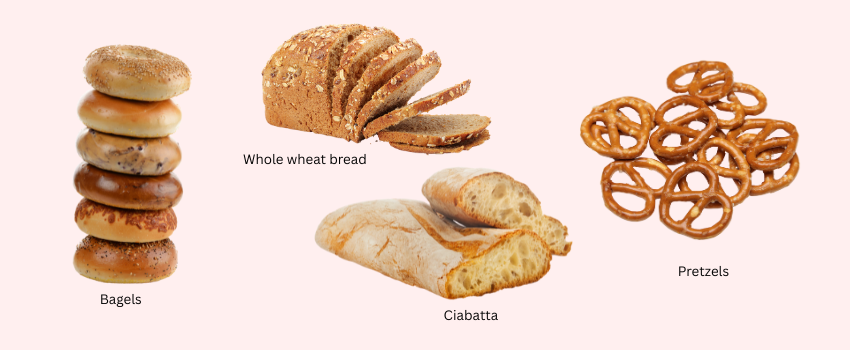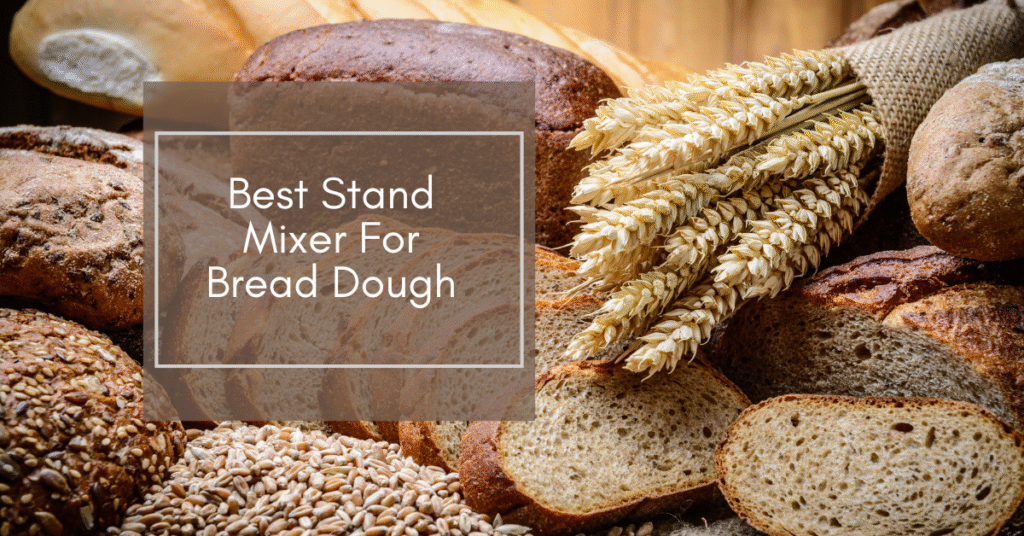Notice: I receive compensation if you buy something through affiliate links on this post. This does not change the price you would pay.
There is something about kneading dough by hand. Something satisfying and relaxing as your hands witness the transformation from a rough mess to a soft, pillowy dough.
However, in certain situations, the best stand mixer for bread dough can provide relief and save you time that you can use for other tasks.
If you make bread often or in large quantities, hand kneading can be tiring and take a lot of time. It’s not an option if, like me, you have persistent shoulder and neck pain.
If you’re a bread enthusiast, a reliable bread mixer is essential. You need one that can handle thick or challenging dough without struggling or overheating.
A good mixer for bread dough must have a powerful motor, solid construction, and efficiently knead various types of bread dough, whether in small or large volumes.
Only a few mixers in the market qualify as bread dough mixers. This guide rounds up the top four.
It tackles their features, performance, benefits, and limitations.
Read on to learn which dough mixer matches your bread-making needs.
Table of Contents
The Best Dough Mixer For Bread
The best mixer for bread dough is one that addresses the specific challenges you encounter when making bread.
High-hydration doughs, stiff bagel doughs, and big batches can be too much for standard kitchen mixers. One of these best dough mixers for home is the answer to those challenging doughs. They are robust and durable.
Each of these kitchen machines has unique strengths, features, and mechanisms. So let’s discuss each one in-depth.
#1- Ankarsrum Assistent
The Ankarsrum uses a roller and scraper system that mimics the motion of hands gently stretching and folding the dough. Like a potter shaping clay on a spinning wheel, it slowly presses and folds the dough against the sides of the bowl, developing gluten gradually without overworking it.
- The scraper continuously pushes the dough toward the center, preventing dry pockets from forming.
- The roller applies gentle pressure, stretching the dough as it spins against the bowl.
- You can adjust the roller manually, pushing it closer or farther from the bowl wall to control the kneading intensity.
This design is particularly effective for high-hydration doughs, such as sourdough or ciabatta, which require a delicate touch to develop structure. However, for denser, low-hydration doughs (such as bagels or sandwich bread), the Ankarsrum requires a bit more hands-on adjustment to ensure everything comes together properly.
What Makes It Stand Out?
✔ Unique kneading action – The roller and scraper work together to efficiently stretch and develop gluten.
✔ Handles wet dough beautifully – Sourdough lovers, this one’s for you. It kneads delicate doughs without overheating or overworking them.
✔ Built to last – The 7-year warranty speaks for itself. This machine is an investment, but it’s made to last decades.
✔ Open bowl design – Easy to add ingredients and see what’s happening while mixing.
✔ Quiet operation – One of the quietest mixers on the market, even at higher speeds.
What to Keep in Mind?
✖ Learning curve – If you’re used to a KitchenAid, the Ankarsrum will take some getting used to. You’ll need to adjust the roller manually for different types of dough.
✖ Pricey – It’s on the higher end, but for dedicated bread bakers, it can be worth every penny.
✖ Less versatile for general baking – While it has a smaller bowl for cookie dough and cakes, it excels particularly with bread.
Who It’s Best For
- Artisan bread bakers and sourdough enthusiasts
- Those looking for a professional-grade mixer
Home bakers who primarily make bread and want a gentler, more hands-on approach to kneading
#2 – KitchenAid 7-Quart Bowl-Lift Stand Mixer
The 7-quart bowl-lift mixer from KitchenAid features a 500-watt motor that delivers smooth and consistent power. If you love the classic planetary mixing action and need a versatile mixer that handles a variety of baked goods, this is a solid choice.
What Makes It Stand Out?
✔ Powerful motor with all-metal gearing – Runs efficiently and quietly.
✔ Familiar mixing action – If you’ve used a KitchenAid before, like me, this one feels right at home but with more power.
✔ Versatile beyond bread – Works well for cake batters, frostings, and general baking needs.
✔ Tons of attachments – From pasta rollers to meat grinders, it can do much more than just knead dough.
What to Keep in Mind?
✖ Struggles with very stiff doughs at max capacity – While powerful, it can struggle when fully loaded with dense doughs like bagels.
✖ Potential heat buildup – Extended kneading sessions can cause some warmth around the motor.
✖ Bowl design quirks – Some users find that ingredients at the bottom of the bowl don’t always fully incorporate.
Who It’s Best For
- Home bakers who want a reliable, multi-purpose mixer.
- Regular bread makers who still want the flexibility for cakes, cookies, and other baked goods
Those who love KitchenAid’s ecosystem and want to use various attachments
#3- Bosch Universal Plus
If the Ankarsrum is like a potter’s wheel, the Bosch is more like a whirlpool churning ingredients.
- The dough hook sits in the center of the bowl and rotates from the bottom, pulling the dough downward while simultaneously spinning it around the central column.
- Because of this motion, the dough is constantly moving and folding over itself, much like a vortex in water.
- This high-efficiency movement enables the Bosch to develop gluten faster than most stand mixers. It’s top-notch for dense whole-wheat doughs or large batches of sandwich bread.
The design prevents flour from flying out when you first start mixing, and the powerful motor ensures even stiff doughs get properly kneaded. However, wet dough can sometimes creep up the center column, and the open design means you need to be mindful of flour or liquids getting into the shaft.
What Makes It Stand Out?
✔ Handles large batches effortlessly – Can knead up to 15 pounds of dough without breaking a sweat.
✔ Powerful motor and unique drive system – The motor is positioned underneath the bowl, enabling efficient mixing with minimal wasted motion.
✔ Prevents flour clouds – Thanks to the closed mixing system, you won’t end up covered in flour when starting a batch.
✔ Long-lasting durability – Many Bosch users report that their mixers last for decades without issues.
What to Keep in Mind?
✖ Plastic construction – While durable, it lacks the aesthetic appeal of metal mixers.
✖ Learning Curve – The dough hook operates differently from traditional mixers, so it takes some time to get accustomed to.
Who It’s Best For
- Bakers who make large batches of bread frequently
- Those who work with whole wheat, rye, and heavy dough
- Home bakers who want a no-frills and efficient dough mixer
#4 – Wolf Gourmet Stand Mixer
The Wolf Gourmet Stand Mixer is a high-end machine that delivers excellent performance and precision. It complements high-end kitchens with its commercial-grade power, smart speed sensing, and slow-start feature.
What Makes It Stand Out?
✔ Smart speed sensor – Automatically adjusts power based on dough resistance, preventing strain.
✔ Premium build quality – Heavy-duty metal construction with a 5-year warranty.
✔ Excellent heat management – Stays cool even during extended kneading sessions.
✔ Precise control – The bowl-lift mechanism and multiple speed settings allow for fine-tuned mixing.
What to Keep in Mind?
✖ Expensive – One of the most expensive stand mixers on the market.
✖ Heavier than most mixers – At over 36 pounds, it’s not easy to move around.
✖ Limited availability – Since it’s a premium brand, finding accessories and service centers can be trickier.
Who It’s Best For
- Luxury-minded bakers who want top-tier performance
- Those who appreciate high-end design and durability
- Home bakers who frequently knead heavy doughs but also want a multi-use mixer
After having gone through the details of the four best bread mixers, let’s dig deeper to learn what makes them excellent and help you pick your match.
Technology Behind The Best Mixer for Bread Dough
The first step to choosing the best stand mixer for bread dough is to understand the technology behind it. Four key factors determine how a mixer handles thick, heavy dough without overheating or struggling. Let’s discuss each one.
1. Motor Power

Torque: DC vs AC Motors
- DC motors deliver consistent power and maintain torque at lower speeds, thereby kneading dough efficiently without bogging down. A DC motor is advantageous if you bake bread often.
- AC motors tend to rev up and slow down, which affects kneading. They don’t provide steady kneading power as well as DC motors do.
Stand mixers with DC motors (such as the KitchenAid Pro Line and the Ankarsrum Assistent) handle stiff doughs more effectively. They don’t overheat as quickly and last longer with heavy use.
Go to this guide to learn more about torque, AC motors, and DC motors
Wattage vs. Actual Kneading Power
Wattage is often equated with power, but there’s more to power than wattage. Some 500-watt mixers can outperform an 800-watt model depending on the motor efficiency and gearing system.
A stand mixer with a well-designed transmission and strong torque will knead bread dough far better than one that boasts of a high wattage. The Bosch Universal Plus, for example, features a 500-watt motor but handles massive batches with ease due to clever engineering.
Why Low-Speed Torque Is Vital for Kneading
A steady, controlled force, not speed, is important in kneading dough. If a mixer can’t maintain high torque at low speed, it will either stall or force you to switch to a higher speed. That can overheat the dough and affect gluten development. Look for models that can handle tough dough at lower speeds without struggling.
2. Mixing Mechanisms
Different mixing actions have different effects on how well ingredients are incorporated and how gluten develops.
Read on.
Planetary Action for General Mixing
The classic stand mixer motion, where the beater moves around the bowl while spinning on its axis (like a planet orbiting the sun). This action ensures even mixing and is suitable for a variety of doughs, but it can sometimes struggle with very stiff bread doughs, especially in lower-end models.
Spiral Systems: The Bread Specialist
In spiral mixers, dough hooks stay stationary while the bowl rotates. It is the gold standard for bread baking because it gently stretches and kneads dough just like a baker’s hands. If you mainly make bread, a spiral mixer is advantageous.
Belt-Driven Systems: Gentle Kneading for Artisan Breads
Some dough mixers, such as the Ankarsrum Assistent, have a unique belt-driven system with a roller and scraper. It’s a different way of mixing, but it works well for high-hydration doughs like ciabatta and sourdough because it mimics the old-fashioned method of hand kneading.
3. Actual Capacity
What size stand mixer do you need for making bread? It will depend on the quantity you make.
But, choosing the right bowl size isn’t just about how much dough you want to mix; it’s also about how much dough you can mix and how much space the dough needs to develop gluten properly.
Finding the Right Bowl Size for Your Baking Volume
- 4.5–5 quarts: Best for small batches or occasional baking.
- 6–7 quarts: Great for frequent bread makers handling medium batches.
- 8+ quarts: Perfect for those who bake large batches or make multiple loaves at once.
Maximum Dough Capacity vs. Advertised Bowl Size
Manufacturers often list bowl capacity in quarts, but that doesn’t always translate to how much dough it can handle. For example, a 7-quart bowl doesn’t mean you can mix 7 quarts of dough.
Check the maximum flour weight capacity (often listed in pounds). Some mixers, like the Bosch Universal Plus, can handle up to 15 pounds of dough, whereas others struggle with half that amount, despite having a similar bowl size.
Headroom: Why Dough Needs Space
Dough expands as it kneads, and if a bowl is too full, gluten won’t develop properly. It’s best to leave at least ⅓ of the bowl empty to allow for proper movement, especially for sticky, high-hydration doughs that climb up the hook.
4. Control and Precision
True Low-Speed Kneading: A Must for Bread
The best dough mixer for bread should be able to knead at a slow, steady pace without stalling. It should not force you to switch to a higher speed to move the dough. Slow kneading helps with gluten development and prevents the dough from getting too hot.
Variable Speed Controls and Their Impact
- More speed settings allow for gradual adjustments, preventing flour from flying everywhere.
- Low speed is vital for mixing and kneading dough effectively.
- Higher speeds help whip eggs or cream butter, but aren’t as important for bread.
I always prefer a mixer with at least six speed settings, though some of the best bread mixers (like the Ankarsrum) only have a simple speed dial, and it works just fine.
Key Takeaway
If you bake bread regularly, investing in a mixer with strong low-speed torque and a durable motor will save you time and effort.
Now, let’s go into the performance elements you should consider when gauging a bread mixer.
Best Mixer For Dough: Essential Performance Factors
Dough Handling Capabilities
A good mixer for bread dough should knead efficiently, whether you’re making soft sandwich loaves or dense bagels. Here’s what to look for:

- High-hydration dough performance (70%+ hydration)
If you love making ciabatta, sourdough, or other wet doughs, your mixer needs to develop gluten without overheating or stalling. Some mixers, like the Ankarsrum Assistent, excel at this because their open-bowl design prevents excessive heat buildup. On the other hand, planetary mixers may require scraping down the bowl more often to ensure proper incorporation. - Stiff dough management (bagels, pretzels)
Stiff doughs put a considerable strain on mixers, so look for a model with a strong motor and metal gears. A weak mixer will struggle, leading to overheating or even motor burnout. Bowl-lift mixers with high torque (like the KitchenAid Pro Line) tend to perform better here. - Whole grain and specialty flour performance
Whole wheat flour soaks up more water, resulting in a denser dough. Some mixers, like the Bosch Universal Plus, are designed to handle these heavy loads, ensuring thorough kneading without straining the motor. If you bake with rye or ancient grains, you’ll want a mixer with steady, consistent kneading action to prevent under-mixed, dense loaves.
Thermal Management
Dough mixing can generate a significant amount of heat. It’s something most people don’t think about until their mixer starts overheating.
- Heat dissipation systems
Some mixers get too warm after just a few minutes of kneading. If you knead for extended periods (10–15 minutes or more), look for a model with good heat management. DC motors tend to run cooler than AC motors. Belt-driven systems reduce friction, helping to prevent excessive heat. - Continuous operation ratings
Some mixers can only run for a few minutes without a cool-down pause, while others (like the Ankarsrum) can knead for up to 30 minutes without rest. If you bake frequently, check how long your mixer can run before overheating. - Overload protection mechanisms
Some mixers automatically shut off if they sense too much strain, which can protect the motor but also be frustrating if it happens mid-knead. High-end models often have better torque management, allowing them to power through thick dough without triggering a safety shutdown.
Build Quality
A bread mixer is an investment. The last thing you want is a mixer that breaks down after a year.
- Gearing systems (metal vs. plastic)
Plastic gears can wear out quickly under heavy loads. While they might be fine for cake batter, they’re not ideal for dense bread dough. For longevity, look for models with all-metal gears. - Housing materials and durability
Mixers with metal housings are generally sturdier and more stable than those made of plastic. An exception is the Bosch Universal Plus, which can knead large batches of heavy dough without flinching.
Practical Considerations
Beyond power and performance, everyday usability matters. A dough mixer should fit your kitchen and lifestyle.
- Counter footprint and storage
Some mixers, such as the Bosch Universal Plus, feature a compact design despite their large capacity. Others, like the KitchenAid Pro Line, are heavier and require more counter space. If you have a small kitchen, think about storage and whether you’ll keep the mixer out or need to tuck it away after use. - Noise levels during operation
A bread mixer should be powerful, but you don’t want one that sounds like a jackhammer. Belt-driven systems and DC motors tend to run more quietly than others. - Accessibility features for users with physical limitations
If you have wrist or shoulder issues, you may find it challenging to maneuver a heavy bowl-lift mixer. Models with side-mounted motors, such as the Ankarsrum Assistent, have easy-to-remove and easy-access bowls. Lighter models and those with ergonomic handles can be helpful.
Next, let’s discuss what went into the selection of the best mixer for bread dough.
Best Dough Mixer for Bread: Selection Criteria
When choosing the best dough mixer for bread, actual performance matters most. So, instead of relying solely on manufacturer claims, I looked at how these mixers perform in everyday baking scenarios. That meant digging into user experiences, reviews from serious home bakers and professionals, and technical insights from trusted sources.
Here are the yardsticks for picking the best mixer for making dough.
Standardized Dough Recipes
To get a fair comparison, it was important to look at mixers handling a variety of dough types, including:
- High-hydration sourdough (75%+ hydration) – An excellent test for how well a mixer develops gluten without overheating.
- Standard sandwich bread (around 65% hydration) – A good benchmark for everyday use.
- Stiff bagel dough (around 55% hydration) – Requires high torque and strong motor power, which is a challenge for most mixers.
- Whole wheat and rye doughs – These are heavier and require more effort to knead properly. Some mixers handle them with ease, while others struggle to do so.
Performance Metrics

Bakers want a bread mixer that kneads dough efficiently, maintains consistent power, and lasts over time. Here are the key factors that went into the evaluation:
- Kneading efficiency – How well does the mixer develop gluten? Does it require scraping down the bowl constantly, or does it mix evenly on its own?
- Motor consistency – Does the mixer slow down or strain with heavier dough? Can it handle continuous kneading without overheating?
- Dough texture and elasticity – Is the dough properly developed after kneading, or does it need extra time?
- Mixer stability – Does the mixer stay in place on the counter, or does it “walk” when kneading stiff dough?
- Noise levels – Some mixers are noticeably quieter than others, which is a big plus for home kitchens.
- Ease of use – How intuitive are the controls? Is the bowl easy to attach and remove?
Testing Environment
Every baker’s kitchen is different, but it’s helpful to consider a controlled environment for comparison:
- Room temperature – Warmer kitchens can affect dough development; therefore, a mixer’s performance was evaluated under standard room conditions.
- Flour type and hydration – Maintaining consistency in these factors helps reveal the actual differences between mixers.
- Kneading times – Comparing how long each mixer takes to develop dough gives insight into motor efficiency and speed control.
Consistency and Repeatability
A good mixer for bread dough shouldn’t just work well once; it should work well and deliver the results consistently. Here’s how repeatability factored into the evaluation:
- Multiple user experiences – Instead of relying on a single source, I gathered feedback from various bakers to ensure consistency in results.
- Common patterns in performance – If multiple users reported overheating with stiff dough, it wasn’t a fluke.
- Long-term durability observations – Some mixers perform well initially but bog down over time. Looking at long-term user feedback helped assess reliability.
Your Shortcut to Better Bread
Kneading dough can be challenging. But you can face the challenge with a bread dough mixer that caters to your bread-making situation.
Now, you know the best of the lot and the factors to consider before you invest in one. You can be confident in your choice with the knowledge you’ve gained..
But is it worth getting a stand mixer for bread? It is if you make large quantities, have physical limitations, or like to delegate tasks to machines so you can focus on other jobs that can’t be delegated.
👉 So, what’s your next move? Making bread can be satisfying. Don’t let fatigue, pain, or time constraints make you give it up. Pick your bread dough mixer, get baking, and experience perfectly kneaded dough in less time and with less effort.



